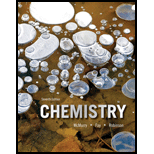
Which element is oxidized and which is reduced in each of the following reactions?
(a)
Want to see the full answer?
Check out a sample textbook solution
Chapter 4 Solutions
Chemistry (7th Edition)
- The iron content of hemoglobin is determined by destroying the hemoglobin molecule and producing small water-soluble ions and molecules. The iron in the aqueous solution is reduced to iron(II) ion and then titrated against potassium permanganate. In the titration, iron(ll) is oxidized to iron(III) and permanganate is reduced to manganese(II) ion. A 5.00-g sample of hemoglobin requires 32.3 mL of a 0.002100 M solution of potassium permanganate. The reaction with permanganate ion is MnO4(aq)+8H+(aq)+5Fe2+(aq)Mn2+(aq)+5Fe3+(aq)+4H2O What is the mass percent of iron in hemoglobin?arrow_forward1. Sometimes a reaction can fall in more than one category. Into what category (or categories) does the reaction of Ba(OH)2(aq) + H+PO4(aq) fit? acid-base and oxidation-reduction oxidation-reduction acid-base and precipitation precipitationarrow_forwardBromine is obtained from sea water by the following redox reaction: Cl2(g) + 2 NaBr(aq) 2 NaCl(aq) + Br2() (a) What has been oxidized? What has been reduced? (b) Identify the oxidizing and reducing agents.arrow_forward
- The carbon dioxide exhaled in the breath of astronauts is often removed from the spacecraft by reaction with lithium hydroxide 2LiOH(s)+CO2(g)Li2CO3(s)+H2O(l) Estimate the grams of lithium hydroxide required per astronaut per day. Assume that each astronaut requires 2.50 103 kcal of energy per day. Further assume that this energy can be equated to the heat of combustion of a quantity of glucose, C6H12O6, to CO2(g) and H2O(l). From the amount of glucose required to give 2.50 103 kcal of heat, calculate the amount of CO2 produced and hence the amount of LiOH required. The H for glucose(s) is 1273 kJ/mol.arrow_forwardGold can be dissolved from gold-bearing rock by treating the rock with sodium cyanide in the presence of oxygen. 4 Au(s) + 8 NaCN(aq) + O2(g) + 2 H2O() 4 NaAu(CN)2(aq) + 4 NaOH(aq) (a) Name the oxidizing and reducing agents in this reaction. What has been oxidized, and what has been reduced? (b) If you have exactly one metric ton (1 metric ton = 1000 kg) of gold-bearing rock, what volume of 0.075 M NaCN, in liters, do you need to extract the gold if the rock is 0.019% gold?arrow_forwardWrite the net ionic equation for the reaction, if any, that occurs on mixing (a) solutions of sodium hydroxide and magnesium chloride. (b) solutions of sodium nitrate and magnesium bromide. (c) magnesium metal and a solution of hydrochloric acid to produce magnesium chloride and hydrogen. Magnesium metal reacting with HCl.arrow_forward
- One of the few industrial-scale processes that produce organic compounds electrochemically is used by the Monsanto Company to produce1,4-dicyanobutane. The reduction reaction is 2CH2CHCH+2H++2eNC(CH2)4CN The NC(CH2)4CN is then chemically reduced using hydrogen gas to H2N(CH2)6NH2, which is used in the production of nylon. What current must be used to produce 150.kg NC(CH2)4CN per hour?arrow_forward4-81 (Chemical Connections 4C) Balance the lithium iodine battery redox reaction described in this sec tion and identify the oxidizing and reducing agents present.arrow_forwardWrite balanced net ionic equations for the following reactions in acid solution. (a) Liquid hydrazine reacts with an aqueous solution of sodium bromate. Nitrogen gas and bromide ions are formed. (b) Solid phosphorus (P4) reacts with an aqueous solution of nitrate to form nitrogen oxide gas and dihydrogen phosphate (H2PO4-) ions. (c) Aqueous solutions of potassium sulfite and potassium permanganate react. Sulfate and manganese(II) ions are formed.arrow_forward
- What is Hrxn for reaction of iron(III) oxide and carbon monoxide to give iron metal and carbon dioxide gas? Use the following reactions: 4Fe(s)+3O2(g)2Fe2O3(s)H=1648.4kJ4CO(g)+O2(g)2CO3(g)H=565.98kJarrow_forwardTriiodide ions are generated in solution by the following (unbalanced) reaction in acidic solution: IO3(aq) + I(aq) I3(aq) Triiodide ion concentration is determined by titration with a sodium thiosulfate (Na2S2O3) solution. The products are iodide ion and tetrathionate ion (S4O6). a. Balance the equation for the reaction of IO3 with I ions. b. A sample of 0.6013 g of potassium iodate was dissolved in water. Hydrochloric acid and solid potassium iodide were then added. What is the minimum mass of solid KI and the minimum volume of 3.00 M HQ required to convert all of the IO3 ions to I ions? c. Write and balance the equation for the reaction of S2O32 with I3 in acidic solution. d. A 25.00-mL sample of a 0.0100 M solution of KIO. is reacted with an excess of KI. It requires 32.04 mL of Na2S2O3 solution to titrate the I3 ions present. What is the molarity of the Na2S2O3 solution? e. How would you prepare 500.0 mL of the KIO3 solution in part d using solid KIO3?arrow_forwardOxidation of 1.00 g of carbon monoxide, CO, produces 1.57 g of carbon dioxide, CO2. How many grams of oxygen were required in this reaction?arrow_forward
 Chemistry & Chemical ReactivityChemistryISBN:9781337399074Author:John C. Kotz, Paul M. Treichel, John Townsend, David TreichelPublisher:Cengage Learning
Chemistry & Chemical ReactivityChemistryISBN:9781337399074Author:John C. Kotz, Paul M. Treichel, John Townsend, David TreichelPublisher:Cengage Learning Chemistry & Chemical ReactivityChemistryISBN:9781133949640Author:John C. Kotz, Paul M. Treichel, John Townsend, David TreichelPublisher:Cengage Learning
Chemistry & Chemical ReactivityChemistryISBN:9781133949640Author:John C. Kotz, Paul M. Treichel, John Townsend, David TreichelPublisher:Cengage Learning Chemistry: Principles and PracticeChemistryISBN:9780534420123Author:Daniel L. Reger, Scott R. Goode, David W. Ball, Edward MercerPublisher:Cengage Learning
Chemistry: Principles and PracticeChemistryISBN:9780534420123Author:Daniel L. Reger, Scott R. Goode, David W. Ball, Edward MercerPublisher:Cengage Learning World of Chemistry, 3rd editionChemistryISBN:9781133109655Author:Steven S. Zumdahl, Susan L. Zumdahl, Donald J. DeCostePublisher:Brooks / Cole / Cengage Learning
World of Chemistry, 3rd editionChemistryISBN:9781133109655Author:Steven S. Zumdahl, Susan L. Zumdahl, Donald J. DeCostePublisher:Brooks / Cole / Cengage Learning Chemistry: The Molecular ScienceChemistryISBN:9781285199047Author:John W. Moore, Conrad L. StanitskiPublisher:Cengage Learning
Chemistry: The Molecular ScienceChemistryISBN:9781285199047Author:John W. Moore, Conrad L. StanitskiPublisher:Cengage Learning General, Organic, and Biological ChemistryChemistryISBN:9781285853918Author:H. Stephen StokerPublisher:Cengage Learning
General, Organic, and Biological ChemistryChemistryISBN:9781285853918Author:H. Stephen StokerPublisher:Cengage Learning





